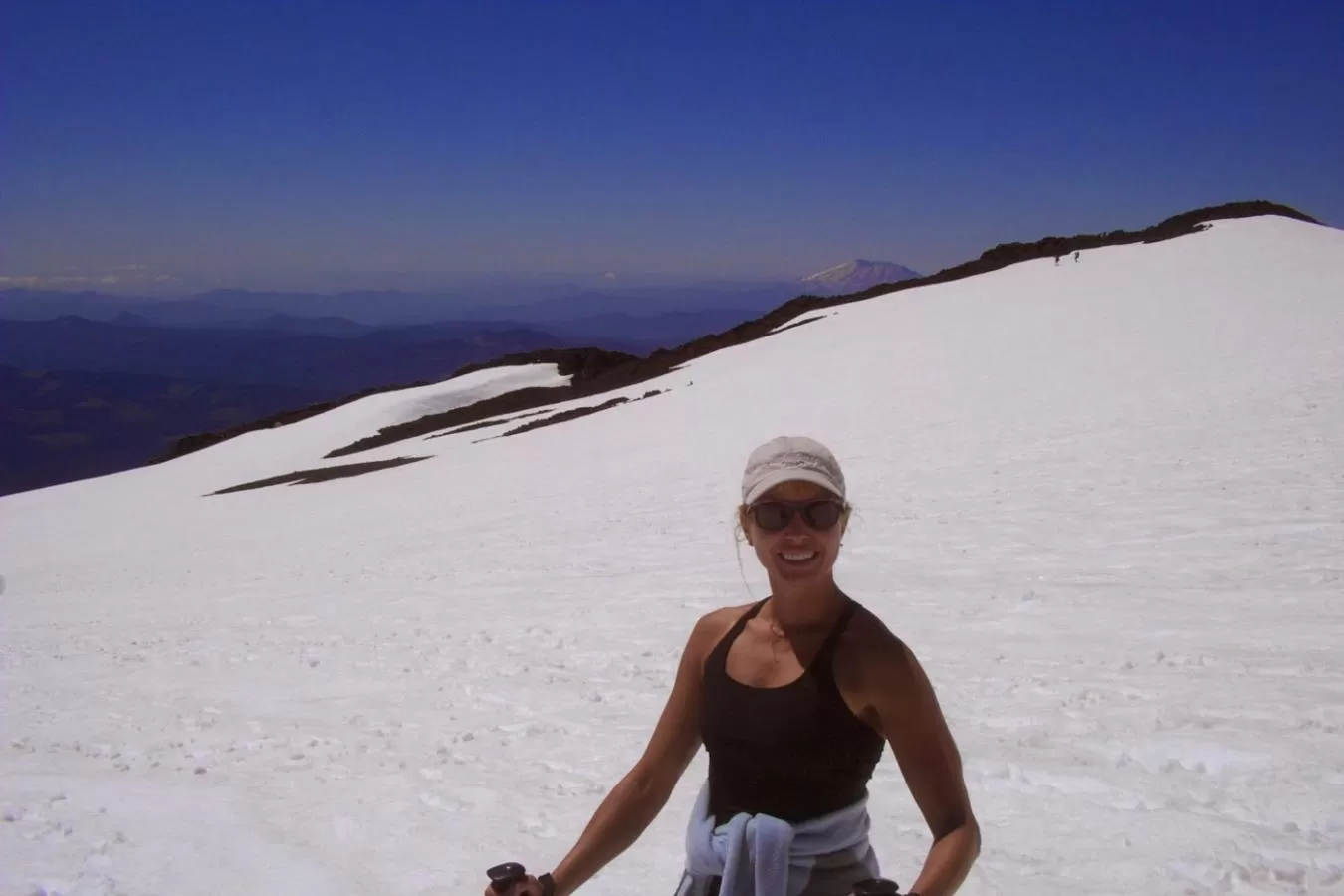Mountaineering in the Heat
Published: 06/16/2021

UV radiation reflects off snow surfaces easily. Maria Faires, RD climbing Mt. Adams.
If temperatures are high when mountain climbing, hyperthermia and sunburn can be issues.
Here are some tips to help you stay comfortable and avoid hyperthermia and sun damage while climbing.
The sun is much harsher at high altitude due to thinner atmosphere (which is our first defense against UV rays) and the rays bounce off snow.
UVA radiation is linked to skin aging and has some role in generating skin cancer.
UVB radiation can cause skin cancer, cataracts and snow blindness.
Defend against the sun's damage by wearing sunscreen. Apply every hour and a half. Everywhere! Sun rays can bounce of the snowy reflective surface and burn the inside of nostrils or ears and even up shorts.
Use a mineral or a sunscreen that has a high percentage of zinc. Zinc acts as a physical barrier between the skin and the sun rays and absorbs the UV light.
Use Zinc oxide used alone at high concentrations or combined with octinoxate (a chemical sunscreen ingredient that works very uniquely with the zinc) for the best broad spectrum sun protection.
Cover up exposed skin. Wear a sunhat, sun shirt, white bandana on your head, a nose shield and good quality glacier glasses with side coverage or these for extreme conditions for maximum protection from sunlight and extreme conditions.
Control your layering to stay as cool as possible. Do not allow yourself to get too warm in the first place. You should always start of your climb or hike comfortably cool. Ask your guide for advice on what to wear on the upper mountain, particular what to wear on your lower body since changing pants on the upper mountain is almost impossible. If you mismanage your clothing choices and have too many layers you will get too hot and sweat. If it is over 45 degrees, wear shorts and layer the clothes on your upper body. Do not wear shorts if you are climbing somewhere that there is a real risk of falling since shorts won't protect your skin. Remember to reapply sunscreen on your legs and up your shorts every 90 minutes.
Wear light colored, loose, wicking clothing which is better than heat absorbing dark fabric or fabric that isn't breathable.
Hydrate well the week before you go on your climb and hydrate optimally during your climb. Follow the guidelines and avoid OVER hydrating. 3 liters for most women and 4 for most men per day is a general safe recommendation.
Hydrate during your climb. On the upper mountain heavy sweat loss isn't much of an issue so most "pro" mountaineers do not use an electrolyte but choose a carbohydrate fuel instead. Any lost sodium can easily be replaced eating salty snacks like salted nuts, Cheetos, pretzels, crackers or jerky. Hikers may benefit because of heavy sweat loss. Do what works best for you though. And practice hydration, eating and electrolytes (if using) before your big climb to see how they make you feel.
Evaporative cooling is effective so put some water or snow on your head or soak your hat in it. As the liquid evaporates it will help cool you down.
Don't push yourself (or other party members) too hard in hot weather. Take regular breaks, drink regularly, and monitor other members of the group for signs of hyperthermia:
- Cool, moist skin with goose bumps when in the heat
- Excessive sweating
- Faintness or dizziness
- Fatigue
- Rapid pulse
- Low blood pressure upon standing
- Muscle cramps
- Nausea
- Headache
Categories: Hiking and Mountaineering
Tags: #exercise
Active Nutrition is a participant in the Amazon Associates Program, an affiliate advertising program designed to provide a way for websites to earn advertising revenues by advertising and linking to Amazon. If you click on one of my recommended item links and then place an order through Amazon, I receive a small commission on that sale, at no extra expense to you of course. This is a way to support me and my work every time you shop at no cost to you.





